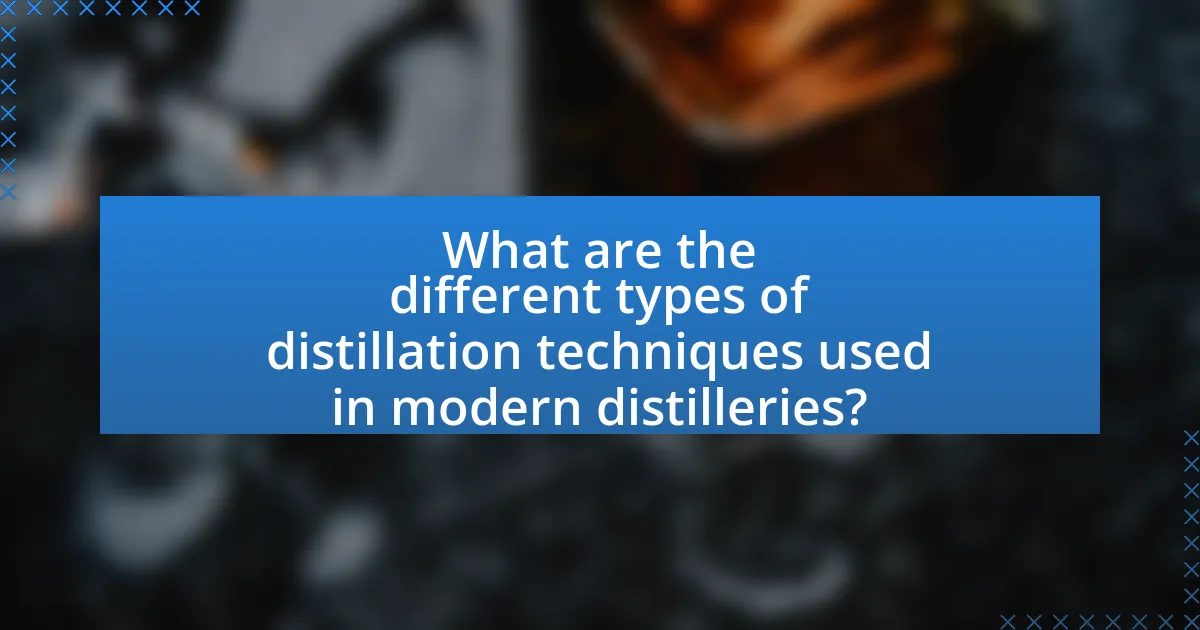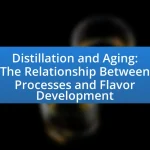The article focuses on the various types of distillation techniques employed in modern distilleries, including pot distillation, column distillation, vacuum distillation, and steam distillation. It outlines the operational differences and specific applications of each method, highlighting how they affect the purity, flavor, and quality of the final spirit. Key characteristics of pot and column distillation are discussed, along with the significance of vacuum distillation in preserving heat-sensitive materials. Additionally, the article examines the advantages and disadvantages of each technique, the factors influencing the choice of method, and best practices for optimizing distillation processes to enhance product quality.

What are the different types of distillation techniques used in modern distilleries?
The different types of distillation techniques used in modern distilleries include pot distillation, column distillation, vacuum distillation, and steam distillation. Pot distillation is a traditional method that involves heating the mash in a pot still, allowing for the separation of alcohol and other components through evaporation and condensation. Column distillation, also known as continuous distillation, utilizes a column still that allows for multiple distillation stages in a single process, resulting in higher purity and efficiency. Vacuum distillation lowers the boiling point of liquids by reducing pressure, which is particularly useful for heat-sensitive materials. Steam distillation employs steam to extract essential oils or volatile compounds from plant materials, making it ideal for producing flavored spirits. Each technique is chosen based on the desired product characteristics and efficiency requirements in the distillation process.
How do these distillation techniques differ from one another?
Distillation techniques differ primarily in their methods of separating components based on boiling points and the specific equipment used. For instance, simple distillation involves heating a liquid to create vapor and then cooling it to collect the liquid, suitable for separating liquids with significantly different boiling points. In contrast, fractional distillation employs a fractionating column to allow multiple vaporization-condensation cycles, enabling the separation of mixtures with closer boiling points, such as in the production of spirits where various alcohols are isolated. Additionally, steam distillation uses steam to extract volatile compounds from heat-sensitive materials, commonly used in essential oil extraction. Each technique’s effectiveness is determined by the boiling point differences and the desired purity of the final product.
What are the key characteristics of pot still distillation?
Pot still distillation is characterized by its use of a traditional, pot-shaped apparatus that allows for batch distillation, resulting in a rich and complex flavor profile in the final spirit. This method typically involves two distillation runs: the first distillation produces a low wine, and the second distillation refines the spirit, concentrating flavors and aromas. Pot stills operate at lower pressures and temperatures compared to column stills, which contributes to the preservation of volatile compounds, enhancing the character of the distilled product. Additionally, pot still distillation is often associated with the production of high-quality spirits such as single malt whisky and certain rums, where the emphasis is on flavor complexity rather than high alcohol yield.
How does column distillation operate compared to pot stills?
Column distillation operates continuously, allowing for a more efficient separation of components compared to pot stills, which operate in batches. In column distillation, the mixture is fed into a tall column where vapor rises and interacts with descending liquid, facilitating multiple distillation stages in a single pass. This results in higher purity and greater alcohol yield, as seen in industrial applications where continuous processes are preferred for large-scale production. In contrast, pot stills require multiple distillation cycles to achieve similar purity levels, making them less efficient for high-volume output.
What is the significance of vacuum distillation in modern practices?
Vacuum distillation is significant in modern practices because it allows for the separation of components at lower temperatures, thereby minimizing thermal degradation of heat-sensitive materials. This technique is particularly valuable in the petrochemical and pharmaceutical industries, where preserving the integrity of compounds is crucial. For instance, vacuum distillation can effectively separate high-boiling point substances without the risk of decomposition, which is essential for producing high-purity products. Additionally, it enhances energy efficiency by reducing the energy required for distillation processes, making it a preferred method in contemporary distillation practices.
Why are these distillation techniques important for distilleries?
Distillation techniques are crucial for distilleries because they directly influence the purity, flavor, and quality of the final product. These methods allow distilleries to separate alcohol from the fermentation mixture, effectively concentrating desirable compounds while removing impurities. For instance, pot still distillation is known for producing rich, flavorful spirits, while column still distillation offers higher efficiency and consistency in alcohol content. The choice of technique impacts not only the sensory characteristics of the spirit but also the overall production efficiency, which can affect profitability. Therefore, the implementation of appropriate distillation techniques is essential for maintaining product standards and meeting consumer expectations in the competitive spirits market.
How do distillation techniques impact the flavor profile of spirits?
Distillation techniques significantly impact the flavor profile of spirits by influencing the separation of volatile compounds during the distillation process. Different methods, such as pot still distillation and column still distillation, yield varying flavor characteristics due to their operational differences. For instance, pot stills allow for a slower distillation process, which retains more of the original flavors and aromas from the raw materials, resulting in a richer and more complex spirit. In contrast, column stills operate continuously and can produce a higher alcohol content with a cleaner taste, often stripping away some of the nuanced flavors. Research indicates that the choice of distillation technique can alter the concentration of esters, phenols, and other flavor compounds, thereby shaping the overall sensory experience of the spirit.
What role does distillation play in the purity of the final product?
Distillation is crucial for achieving the purity of the final product by separating components based on their boiling points. This separation process allows for the removal of impurities and unwanted substances, resulting in a more refined and concentrated product. For instance, in the production of spirits, distillation can eliminate fusel oils and other volatile compounds that may affect flavor and quality. The effectiveness of distillation in enhancing purity is evidenced by its widespread use in industries such as pharmaceuticals and petrochemicals, where high purity levels are essential for product efficacy and safety.

What are the advantages and disadvantages of each distillation technique?
The advantages and disadvantages of distillation techniques vary significantly among methods such as simple distillation, fractional distillation, steam distillation, and vacuum distillation. Simple distillation is advantageous for its ease of use and low cost, making it suitable for separating liquids with significantly different boiling points. However, it is limited in efficiency and cannot effectively separate mixtures with close boiling points. Fractional distillation offers higher efficiency and better separation of components with similar boiling points, but it requires more complex equipment and is more time-consuming. Steam distillation is beneficial for extracting heat-sensitive compounds without decomposition, yet it may not be suitable for all substances and can lead to lower yields. Vacuum distillation allows for the distillation of substances at lower temperatures, preserving heat-sensitive materials, but it necessitates specialized equipment and can be more expensive. Each technique has its specific applications, making the choice dependent on the desired outcome and the nature of the substances involved.
What benefits does pot still distillation offer?
Pot still distillation offers the benefit of producing spirits with a rich and complex flavor profile. This method allows for the retention of more congeners and aromatic compounds, which contribute to the depth of flavor in the final product. Additionally, pot stills operate at lower distillation speeds, enabling better separation of volatile compounds, which enhances the overall quality of the spirit. Historical evidence shows that traditional pot still distillation has been used for centuries, particularly in the production of whiskey and rum, underscoring its effectiveness in creating high-quality spirits.
How does pot still distillation enhance the complexity of flavors?
Pot still distillation enhances the complexity of flavors by allowing for a slower, more controlled distillation process that retains a greater variety of volatile compounds. This method involves the use of a pot still, which operates in batches and enables the distiller to separate the distillate into heads, hearts, and tails, capturing a broader spectrum of flavors and aromas. The unique shape of pot stills also contributes to this complexity, as they promote reflux, allowing lighter and heavier compounds to interact and develop richer flavor profiles. Studies have shown that spirits produced through pot still distillation often exhibit more nuanced and layered flavors compared to those produced using column stills, which tend to focus on higher purity and efficiency at the expense of flavor complexity.
What are the limitations of using pot stills in production?
Pot stills have several limitations in production, primarily related to efficiency and consistency. They typically produce lower alcohol by volume (ABV) compared to column stills, often resulting in a final product with a higher concentration of congeners, which can affect flavor but may also lead to less control over the distillation process. Additionally, pot stills require more labor and time for distillation, as they operate in batch mode rather than continuously, making them less suitable for large-scale production. This batch process can also lead to variability between batches, impacting product consistency. Furthermore, pot stills are less efficient in separating volatile compounds, which can limit the ability to produce spirits with specific flavor profiles or purity levels.
What are the advantages of column distillation?
Column distillation offers several advantages, including higher efficiency, better separation of components, and continuous operation. The design of column distillation allows for multiple theoretical plates, which enhances the separation of mixtures by providing a larger surface area for vapor-liquid contact. This results in a more refined product with fewer impurities. Additionally, column distillation operates continuously, making it suitable for large-scale production, which increases throughput and reduces operational costs. These benefits make column distillation a preferred method in modern distilleries for producing high-purity spirits and other distilled products.
How does column distillation improve efficiency in production?
Column distillation improves efficiency in production by enabling continuous separation of components, which reduces processing time and energy consumption. This technique utilizes a vertical column filled with packing material, allowing for multiple vaporization and condensation cycles within a single unit. As a result, column distillation achieves higher purity levels and greater throughput compared to traditional batch distillation methods. Studies indicate that column distillation can increase production efficiency by up to 50%, making it a preferred choice in modern distilleries for large-scale operations.
What challenges do distilleries face when using column distillation?
Distilleries face several challenges when using column distillation, primarily related to efficiency, product quality, and operational costs. Column distillation requires precise temperature control and can lead to the loss of volatile compounds, which may affect flavor profiles. Additionally, the initial investment in column distillation equipment is significant, and ongoing maintenance can be costly. Furthermore, distilleries must manage the complexity of the distillation process, as improper operation can result in lower yields and inconsistent product quality. These challenges highlight the need for skilled operators and robust quality control measures to ensure optimal performance in column distillation.

How do modern distilleries choose the appropriate distillation technique?
Modern distilleries choose the appropriate distillation technique based on the desired flavor profile, alcohol content, and the specific characteristics of the raw materials used. Distillers evaluate factors such as the type of spirit being produced, the efficiency of the distillation process, and the equipment available. For instance, pot stills are often selected for their ability to produce rich, complex flavors, while column stills are preferred for higher purity and efficiency in producing neutral spirits. The choice is also influenced by historical practices and regional traditions, ensuring that the final product aligns with consumer expectations and market demands.
What factors influence the choice of distillation method?
The choice of distillation method is influenced by factors such as the nature of the feedstock, desired purity of the product, energy efficiency, and scale of production. Different feedstocks, such as grains or fruits, require specific distillation techniques to optimize extraction and flavor profiles. For instance, pot stills are often used for their ability to produce richer flavors, while column stills are preferred for higher purity and efficiency in large-scale operations. Energy efficiency is also a critical consideration, as methods that minimize energy consumption can significantly reduce operational costs. Additionally, the scale of production dictates whether a continuous or batch distillation process is more suitable, impacting the overall choice of method.
How does the type of spirit being produced affect the choice of technique?
The type of spirit being produced significantly influences the choice of distillation technique. For instance, the production of whiskey typically requires pot still distillation to achieve a rich flavor profile, while vodka production often utilizes column still distillation for a higher purity and neutral taste. This distinction is rooted in the desired characteristics of the final product; whiskey benefits from the complex flavors developed during pot still distillation, whereas vodka aims for a clean, smooth finish that is best achieved through continuous distillation methods.
What role does production scale play in selecting a distillation method?
Production scale significantly influences the selection of a distillation method, as larger scales typically require more efficient and continuous processes, while smaller scales may utilize batch methods. For instance, large-scale distilleries often opt for continuous column distillation due to its ability to process large volumes of liquid with consistent quality and lower operational costs, as evidenced by the widespread use of this method in industrial applications. Conversely, smaller distilleries may prefer pot stills for their ability to produce unique flavors and higher quality spirits, which aligns with the artisanal approach often sought in craft distilling. Thus, the production scale directly impacts the choice of distillation technique based on efficiency, cost-effectiveness, and desired product characteristics.
What are some best practices for implementing distillation techniques?
Best practices for implementing distillation techniques include ensuring proper equipment calibration, maintaining optimal temperature control, and conducting regular maintenance on distillation apparatus. Proper calibration of equipment, such as stills and condensers, ensures accurate separation of components, which is critical for product quality. Maintaining optimal temperature control is essential for achieving desired separation efficiency; for instance, precise temperature settings can enhance the purity of the distillate. Regular maintenance of distillation apparatus prevents breakdowns and ensures consistent performance, as highlighted by industry standards that recommend routine inspections and cleaning to avoid contamination and inefficiencies.
How can distilleries optimize their distillation processes for quality?
Distilleries can optimize their distillation processes for quality by implementing precise temperature control and utilizing advanced distillation techniques such as fractional distillation. Precise temperature control ensures that the distillation occurs at optimal points, allowing for the separation of desired compounds while minimizing impurities. Fractional distillation, which involves multiple distillation stages, enhances the purity of the final product by allowing for better separation of volatile components based on their boiling points. Research indicates that distilleries employing these methods can achieve higher quality spirits, as evidenced by a study published in the Journal of Agricultural and Food Chemistry, which found that improved distillation techniques significantly increased the flavor profile and overall quality of distilled beverages.
What common troubleshooting tips can help improve distillation outcomes?
To improve distillation outcomes, ensure proper temperature control throughout the process. Maintaining the correct temperature is crucial because it affects the volatility of components, leading to better separation. Additionally, regularly check and calibrate equipment to prevent inaccuracies that can compromise product quality. For instance, a study by the American Chemical Society highlights that precise temperature management can enhance the purity of distillates by up to 30%. Furthermore, monitor the feed composition, as variations can impact the efficiency of separation, necessitating adjustments in operational parameters.


